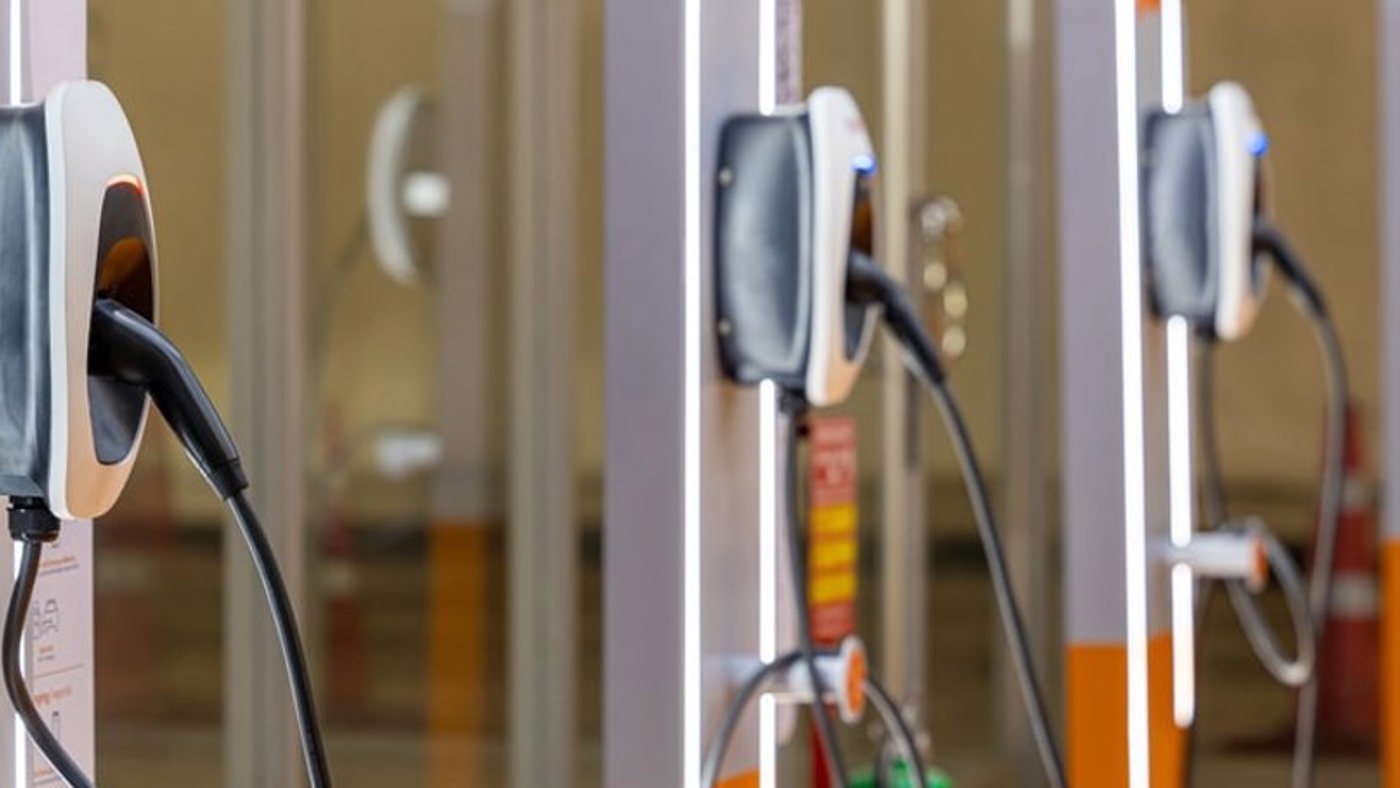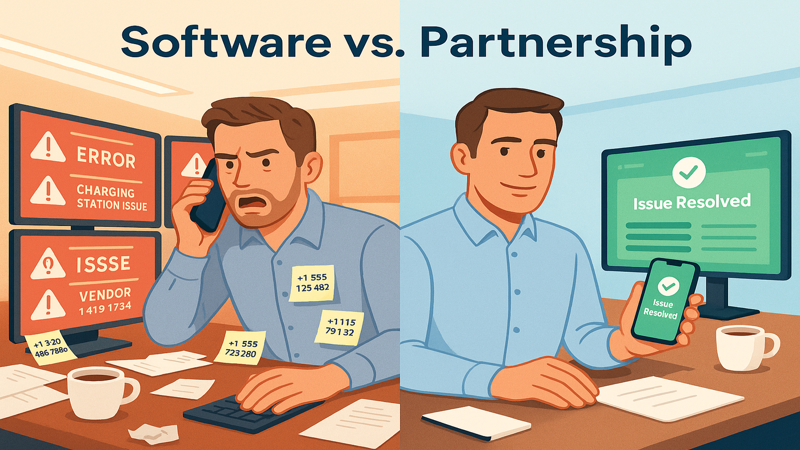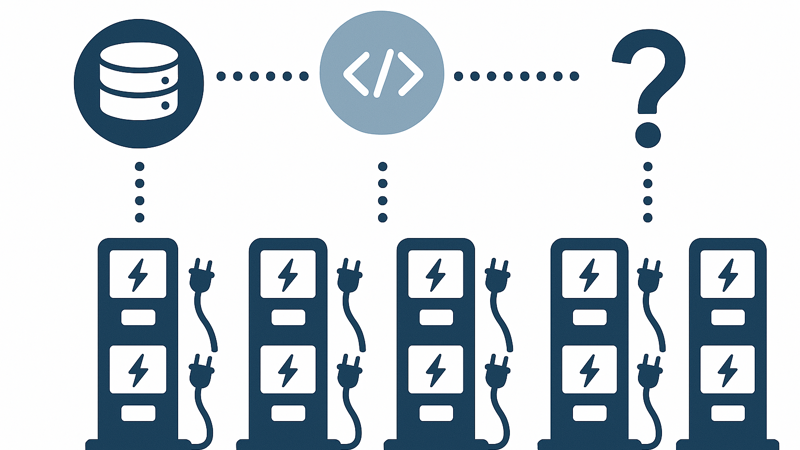
Nine Things to Consider For Your EV Fleet Transition
In 2024, 22% of all new cars sold must be electric. By 2035, this will be 100%.
Most fleet managers are aware of the UK government’s 2035 deadline, and 54% of them plan to switch to a fully electric fleet within the next five years.
However, there is yet to be a clear path to begin this transition.
27% of fleet managers said that costs are a significant roadblock. A further 24% said a lack of connectivity was to blame.
It’s confusing even to know where to start.
Do you invest in a new fleet of vehicles, a charge point set-up, or software?
With the right planning and considerations, the transition doesn’t have to be costly. It can even be profitable thanks to cheaper off-peak energy tariffs and deploying charge points to the public.
Here are nine key considerations when beginning your transition to an electric fleet:
1. Software First
When transitioning to Electric Vehicles (EVs), it’s tempting to go big.
Investing in flash new charge points and top-of-the-range vehicles are attractive options and the most common starting points for fleet transitions.
However, investments in hardware come at a high price, both in installation time and costs.
It’s important to ensure your hardware falls under the Open Charge Point Protocol (OCPP), allowing chargers to run on any OCPP-compliant software.
If chargers aren’t OCPP compliant fleet managers can get stuck using basic back-office software.
Down the line this may lead to issues with compatibility and ultimately hinder fleet management, as operators will have to juggle multiple systems.
Choosing well-designed management software can help you understand which chargers are OCPP compliant and avoid costly mistakes by providing the insights you need to make informed decisions about your fleet transition.
2. Scalability
Your fleet size isn’t static. As your business grows, so too will the number of EVs.
As a result, there will be increased demands from your management software.
As sales of EVs continue to grow, with projected usage being 22.6% of all commercial vehicles in 2024, there will likely be increased stress on your charging network.
An overload of users in a network that is not able to adapt can lead to a complete shutdown, making your workforce immobile. This can cost up to £700 a day per vehicle.
When beginning an EV transition, it’s important to consider if your management software can handle these changing loads.
Does it have a robust network of servers that allow for adding more charge points or users, for example?
Has it been stress-tested to deal with peak charging demands?
At Clenergy, we employ a multiple server system, which means even at maximum capacity, we can support a charging system simply by opening another one.
Our charging system never goes offline, so you can scale your electric fleet without worrying about potential downtime.
3. Grants Available
Recently, the Office for Zero Emission Vehicles (OZEV) announced a series of multiple different grants to support businesses and local authorities in their transition.
For example, the Workplace Charging Scheme can cover up to 75% of the total costs for each charging point installed if there is a need for vehicles in the operation of their business.
For local authorities, there is the On-Street Residential Campaign, which can cover up to 50% of costs for eligible “slow charging” public charge points.
These grants offer a great opportunity for fleet managers to save on their transition to an electric fleet.
At Clenergy, we offer a complete reporting system on the usage of workplace EV chargers, helping you see if you qualify for OZEV schemes and grants.
4. Meeting Public Charge Point Regulations
We’re far from the infancy of the mid-2000s when it comes to charging infrastructure. Along this journey, the government has regularly introduced stricter regulations for publicly available chargers.
In September of 2023, authorities introduced new regulations that included a 99% reliability requirement and mandated contactless payment.
While compliance with these regulations may seem solely the concern of owners of public charge point networks, local authorities and businesses stand to benefit from meeting public charge point regulations.
Privately owned Charge Points can be deployed into the public sector when not in use, allowing your business to make money from your fleet transition.
5. Security
Digital security is one of the most important parts of any operation today.
Breaches in GDPR can lead to hefty penalties, with Amazon recently fined £746 million for a data breach.
Not only is data at risk, but hackers can attack EV chargers, too.
Infamously, hackers targeted a charging station in the Isle of White and manipulated the screens to display indecent content.
It’s essential to consider the security of your management software when beginning an EV transition. There are a few key features to look out for:
- ISO is the leading international standard on digital security. Their certification means providers are handling your data with the highest standards.
- Full encryption is also crucial. It means outside parties can’t intercept your data.
- In the UK, the government offers a “cyber-essentials” certification. This holds management systems to account and adds another layer of security.
- A proactive risk management plan is vital to ensure that if there is a threat, there is a process in place to deal with it swiftly.
- It’s also important that your software supplier vets their third-party suppliers. Problems in your provider's supply chain can mean problems for you.
Our network is fully encrypted and ISO27001 certified, so you have one less concern when beginning your EV transition.
6. Driver Reception
For fleet managers, the benefits of a transition to an electric fleet may seem clear and necessary.
However, it’s important to remember who it will directly affect: the driver.
About 38% of drivers have concerns about EVs’ ability to support them for long distances due to not having anywhere to charge their car.
These fears must be dealt with by fleet managers when making the switch, or the view that electric vehicles are impractical may linger among workers.
This can lead to reduced morale, which can affect day-to-day operations post-transition.
At Clenergy, we offer a 24/7 customer support line for addressing driver inquiries, complemented by extensive off-site charging infrastructure with 300,000 stations spread across the UK and Europe on our network.
Additionally, we offer payment by RFID, fuel cards, fobs, contactless card payment, online payment, Google Pay and Apple Pay for a quick tap-and-go recharging experience to help alleviate your drivers’ concerns.
We’re also driving forward e-roaming on our Clenergy App across multiple different charging networks, while putting fleet managers in control of how much is spent on your vehicle charges.
7. Off-Site Availability
A common issue companies find when switching to a fully electric fleet is the ability to charge vehicles away from a centralised depot, also known as off-site charging.
When the average business vehicle covers about 10,000 miles per year, it’s natural that there will be periods when the vehicle can’t make it back to a centralised charging location.
It’s vital to consider whether your management software is supported by E-Roaming.
A network without this feature will severely limit the range of your fleet by only allowing your vehicles to charge with compatible locations.
By using a provider with signed E-Roaming agreements, you allow your fleet to charge at multiple locations regardless of who is operating the charging points. This means your fleet can charge when and where your employees need to, but alongside that, we also offer full control over which charge points employees are using. If you notice a particularly expensive charge point available on the network, you can prevent your fleet from charging and direct them to nearby cheaper sites to help monitor your running costs.
Our network has over 300,000 charging points nationwide, so customers can charge wherever their journey takes them, all with a simple card tap, while allowing for the control of how much a fleet spends.
8. Types of Chargers
Another consideration to make when beginning the transition to an EV fleet is the type of chargers you choose.
“Slow” chargers can take up to 12 hours to charge. “Rapid” ones can take just 20 minutes.
While it may be tempting to jump straight to the fastest option possible, it’s important to remember that the faster the charger, the greater the power demand.
A suite of high-powered rapid chargers will cost much more than a suite of slower chargers, so businesses should choose the right charger for their usage case.
If you’re simply charging a fleet overnight, it may be better to save on electrical costs and opt for slower chargers, and have rapid chargers available in case of an emergency.
At Clenergy, our fleet management software can manage both kinds of chargers so that you can build a charging network perfectly suited to your fleet’s needs.
9. Location of Chargers
The government's 2022 “Charging Ahead” report detailed the importance of location when opening up charge points to the public.
Considering location may seem like an issue limited to charging stations operated by local authorities.
However, for private enterprises looking to open up their network to the public, it’s a key aspect to consider.
Opening your private network to the public can be a great way to make money from your EV transition.
At Clenergy, our network records footfall so you can pick the right place to make the most out of your charging network.
Moving forward
The need for transition to a fully electric fleet is becoming clearer. Despite the 2035 push-back, the deadline still looms. And the corporate market is driving the transition forward, over 40% of corporate leased cars are EV’s, and as each year passes, the accessibility of EV’s is greater.
Charging Point Operators should not be rash in their choices; it’s essential to consider every option before you begin this journey.
If you’re interested in beginning your EV transition and are looking for a trusted partner to help scope out and tackle your challenges, please contact us through the credentials below.


